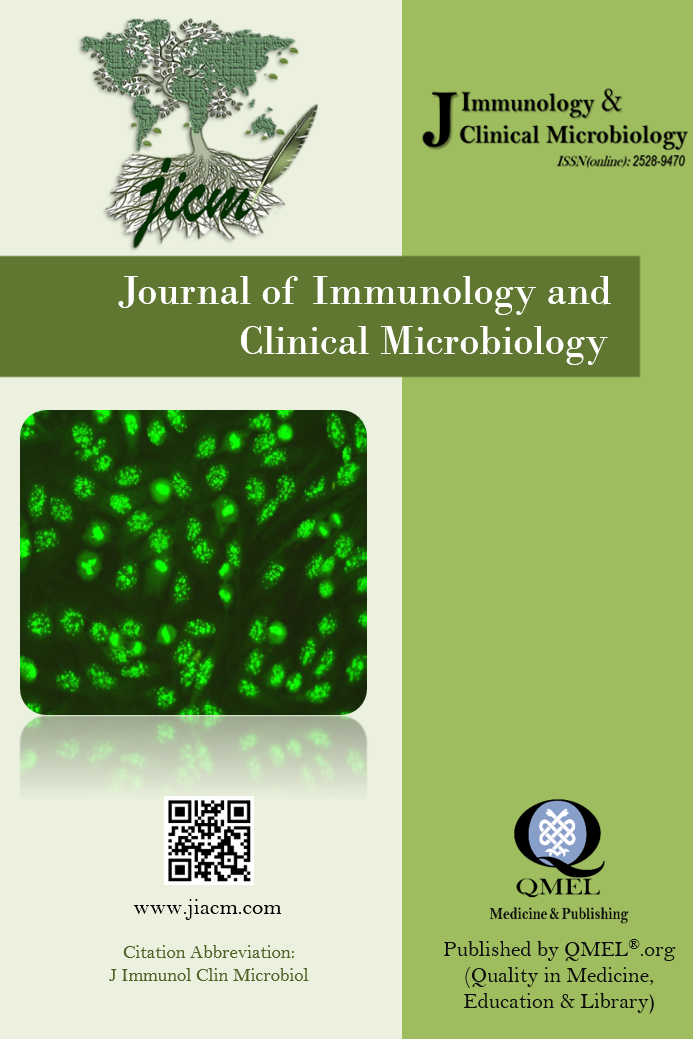Characterization of lymphocyte infiltration in molar pregnancies
Characterization of lymphocyte infiltration in molar pregnancies
Background: In
normal pregnancy around 30% of stromal cells in decidualised endometrium are
leucocytes, lymphocyte subtypes may play a role in the pathogenesis of molar
pregnancies.
The aim of the study is to
investigate the pattern of infiltrating lymphocytes in paraffin embedded tissue
sections obtained from molar pregnancies.
Material and Methods: This study included thirty-five archived paraffin-embedded
samples of molar pregnancies; divided into 16 incomplete and 19 complete
hydatid mole. Then dual immunofluorescence staining was used for phenotyping of
lymphocytic infiltrate (CD3- CD19) and (CD4-CD8). Independent sample t-test was
used to compare the mean cell counts between different study groups.
Results: There
is higher T cells (CD3) infiltrate in complete hydatid mole than normal
placental tissue (p=0.003) and not significant with incomplete hydatid mole
(p=0.089). Plasma cells (CD19) were higher in both complete hydatid mole CHM
(p=0.012) and incomplete hydatid mole
iCHM (p=0.013). Cytotoxic cells (CD8) were none significant in all
groups while Helper cells (CD4) were significantly higher in CHM (p=0.017) and
iCHM (p=0.025).
Conclusion: The
higher tissue infiltration with plasma cells and helper cells in both CHM and
iCHM highlight the importance of these cells in molar pregnancy pathogenesis.
___
- Bulmer JN, Morrison L, Longfellow M, Ritson A, Pace D. Granulated lymphocytes in human endometrium: histochemical and immunohistochemical studies. Hum Reprod 1991; 6: 791-798.
- Jones RK, Bulmer JN, Searle RF. Phenotypic and functional studies of leukocytes in human endometrium and endometriosis. In: Human Reproduction Update. 1998. page 702–709.
- Pace D, Longfellow M, Bulmer JN. Characterization of intraepithelial lymphocytes in human endometrium. J Reprod Fertil 1991; 91: 165-174.
- Vassiliadou N. Quantitative analysis of T lymphocyte subsets in pregnant and nonpregnant human endometrium. Biol Reprod 1996; 55: 1017-1022.
- Scaife PJ, Bulmer JN, Robson SC, Innes B a, Searle RF. Effector activity of decidual CD8+ T lymphocytes in early human pregnancy. Biol Reprod 2006; 75: 562–567.
- Sebire NJ, Unit TD, Hospital CC. Histopathological diagnosis of hydatidiform mole: contemporary features and clinical implications. Fetal Pediatr Pathol 2010; 29: 1-16.
- Sanguansermsri D, Pongcharoen S. Pregnancy immunology: Decidual immune cells. Asian Pacific J Allergy Immunol 2008; 26: 171-181.
- Kirk E, Papageorghiou AT, Condous G, Bottomley C, Bourne T. The accuracy of first trimester ultrasound in the diagnosis of hydatidiform mole. Ultrasound Obstet Gynecol 2007; 29: 70-75.
- Sunderland C a, Bulmer JN, Luscombe M, Redman CW, Stirrat GM. Immunohistological and biochemical evidence for a role for hyaluronic acid in the growth and development of the placenta. J Reprod Immunol 1985; 8: 197-212.
- Knoeller S, Lim E, Aleta L, Hertwig K, Dudenhausen JW, Arck PC. Distribution of immunocompetent cells in decidua of controlled and uncontrolled (choriocarcinoma/hydatidiform mole) trophoblast invasion. Am J Reprod Immunol 2003; 50: 41-47.
- Szekeres-Bartho J. Immunological relationship between the mother and the fetus. Int Rev Immunol 2002; 21: 471-495.
- Wongweragiat S, Searle RF, Bulmer JN. Decidual T lymphocyte activation in hydatidiform mole. J Clin Pathol 1999; 52: 888-894.
- Dickson-González SM, García de Barriola V, Barbella-Aponte RA, Figueira L, Cortés-Charry R, Naranjo de Gómez M. Histopathologic and immunohistochemical evaluation of blood vessels in complete and partial hydatidiform mole. J Reprod Med 2006; 51: 933-937.
- Jokhi PP, King A, Loke YW. Cytokine production and cytokine receptor expression by cells of the human first trimester placental-uterine interface. Cytokine 1997; 9: 126-137.
- Verma S, Hiby SE, Loke YW, King A. Human decidual natural killer cells express the receptor for and respond to the cytokine interleukin 15. Biol Reprod 2000; 62: 959-968.
- Bertone S, Schiavetti F, Bellomo R, Vitale C, Ponte M, Moretta L, Mingari MC. Transforming growth factor-β-induced expression of CD94/NKG2A inhibitory receptors in human T lymphocytes. Eur J Immunol 1999; 29: 23-29.
- Mingari MC, Ponte M, Bertone S, Schiavetti F, Vitale C, HLA class I-specific inhibitory receptors in human T lymphocytes: interleukin 15-induced expression of CD94/NKG2A in superantigen- or alloantigen-activated CD8+ T cells. Proc Natl Acad Sci USA 1998; 95: 1172-1177.
- Pongcharoen S, Bulmer JN, Searle RF. No evidence for apoptosis of decidual leucocytes in normal and molar pregnancy: implications for immune privilege. Clin Exp Immunol 2004; 138: 330-336.
- Xu Y, Plazyo O, Romero R, Hassan SS, Gomez-Lopez N. Isolation of Leukocytes from the Human Maternal-fetal Interface. J Vis Exp 2015; (99): e52863.
- Liliana N, Mihael A, Maria M, Manolea S. The vasculogenesis – a possible histological identification criterion for the molar pregnancy. Rom J Morphol Embryol 2011; 52: 61-67.
- Yayın Aralığı: Yılda 4 Sayı
- Başlangıç: 2016
- Yayıncı: Erkan YULA
